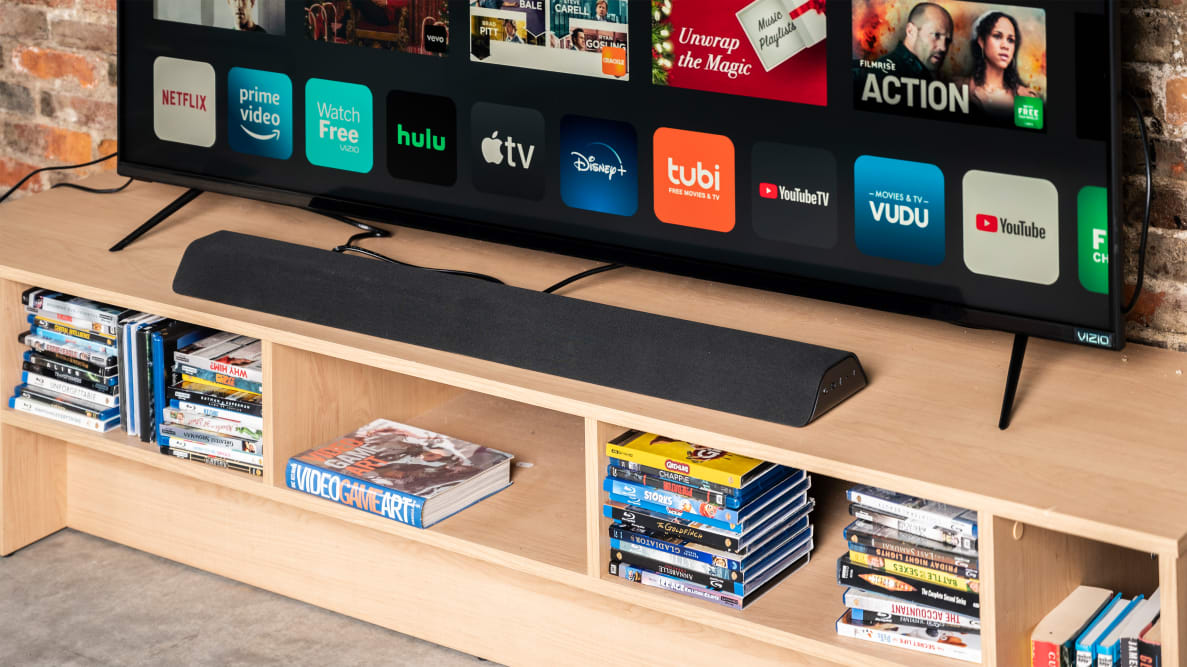Pros
-
Easy to set up and use
-
Great for music
-
Effective virtual surround
Cons
-
Limited bass
-
Occasional weak dialogue
-
No Wi-Fi
It should come as no surprise that Vizio infused the AIO with stellar sound for a reasonable price. From the V Series 2.1 to the company’s impressive Dolby Atmos bars like the SB36512-F6, Vizio has built quite a reputation for packing its audio products with exceptional sound without reflecting it in the bars’ retail price. With a six-driver array, simplistic equalizer options, and capable DTS Virtual:X, the AIO is well-equipped in the sound department among products in its price range.
As inevitably tends to be the case, however, the savings come at a cost. The dual "subwoofers" built into the bar may be convincing for casual music listening, but are exposed when movies and TV shows demand more of them. While the bar does offer different connectivity options for Amazon Alexa or Google Assistant devices, it’s missing the modern comfort of built-in WiFi. And when the bar is tasked with recreating a full theater experience in action-heavy movies and shows, areas like dialogue fall through the cracks. That said, many looking for a compact soundbar in this price range might not be overly concerned with those faults.
About the Vizio M Series All-In-One Soundbar
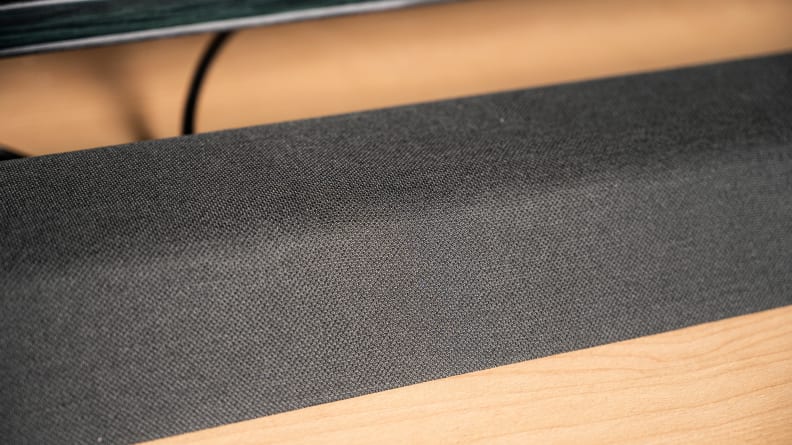
Here’s a look at the Vizio M Series All-In-One Soundbar’s specifications:
- Height x Width x Depth: 2.2 inches x 36 inches x 4.5 inches
- Weight: 6 pounds
- Speakers/drivers: two 2-way speakers with separate tweeters and woofers; two 3-inch subwoofers.
- Wireless connection: Bluetooth
- Wired connection: HDMI ARC input/output, HDMI input, 3.5mm analog audio input, optical audio input, USB input
- Sound formats: DTS Virtual:X, Dolby Audio
- Video support: 4K HDR, Dolby Vision passthrough
Vizio didn’t skimp on accessories for the AIO, which is only notable because low-cost soundbars often do. In addition to the bar and remote, Vizio included an HDMI cable, a digital optical cable, a 3.5mm auxiliary cable, and a 3.5mm-to-RCA cable. It’s not the biggest of bonuses, but for those who won’t have to go rummaging around their drawer of loose cables to find a way to connect to your TV, it’s a greatly appreciated perk.
The AIO will also be appealing to many simply because of its size and angular shape. The bar's 36-inch width isn't exceedingly tiny by soundbar standards, but it certainly qualifies as compact. Additionally, omitting a wireless subwoofer means the overall package of the AIO is significantly less intrusive than the counterparts that do have separate subs. You won't have to carve out room in your living room to fit a subwoofer enclosure, or find spots to position rear speakers. The slender AIO conveniently slides right into place beneath your TV.
What we like
Tremendously simple to use
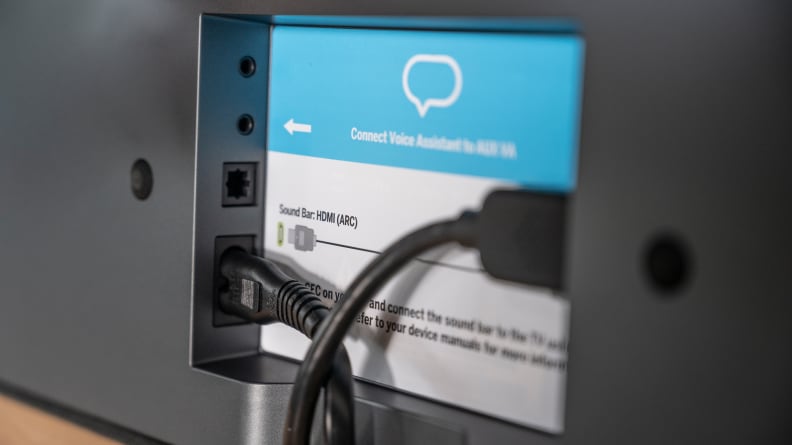
Everything about this bar, be it the setup process or the handy included remote, exudes simplicity. The AIO has just about every input you could want, including a second HDMI input that essentially acts as a replacement for the HDMI ARC port potentially occupied by the soundbar on your TV, allowing you to control the bar's volume and power with your TV remote.
Plus, one of the few perks of a WiFi-less soundbar is being able to skip the sometimes tedious task of getting the bar connected to your network. Regardless of what connection (or cable) you end up using between the soundbar and your TV, it’s a remarkably effortless plug-and-play experience.
Controlling the bar is just as streamlined. The remote has dedicated buttons for bass, treble, Night Mode, and DTS Virtual:X, as well as an EQ button that will toggle the soundbar through Movie, Music, Gaming, and Dialogue presets. Changes in volume, bass, or treble are reflected by a small display on the bar's front, and the system will literally tell you which EQ preset is engaged as you navigate through them. There’s even an input key on the back of the remote to help decipher what the colors on the bar’s display correspond to, and a built-in scroll pad that can do things like change tracks when listening to music through a connected Bluetooth device.
It’s clear that Vizio made a considerable effort to make functionality a priority with the AIO, and that shouldn’t go overlooked. How easy a soundbar is to use is just as important as how it sounds to some, and the AIO provides a straightforward infrastructure that allows even the least tech-savvy folks to power up their new soundbar and use it effectively across sources.
Stellar for music listening
The AIO soundbar is a sneakily good product for listening to music. Conventional knowledge suggests that it shouldn’t be, since its short frame indicates that it won't offer the kind of stereo separation found in longer bars or discrete speaker setups. Further, while the lack of a wireless subwoofer saves space, it generally leads to less-than-thrilling bass. To be clear, I wouldn’t put the AIO in the same conversation as a bar like the Klipsch Cinema 400, which is physically better positioned to sound great thanks to its massive wireless subwoofer and horn tweeters. But make no mistake: for music, the AIO kind of rocks.
The overall sound is pleasantly detailed, and the AIO has no issues filling a larger room with distortion-free sound. Those mini subwoofers actually do just enough to provide the low end needed to enjoy most genres of music, though they're not ideal for bass-heavy pop and hip-hop tracks. Essentially, if your typical music sessions are filled with lots of Lizzo or Lil Dicky, you might not be enamored with this bar’s output. But if you’re listening to music that doesn’t require substantial bass to sound as it was intended—anything from Stevie Ray Vaughn to Jack Johnson—the AIO is ready and willing to do the job.
After some reflection, I concluded that I was mainly excited by the AIO's music abilities because it caught me by surprise. I was initially counting on this bar to be an improvement over standard TV speakers for movies and TV, and not much more. If you come into listening to the AIO with those kinds of realistic expectations, you’ll likely be delighted by what you hear.
Effective virtual sound
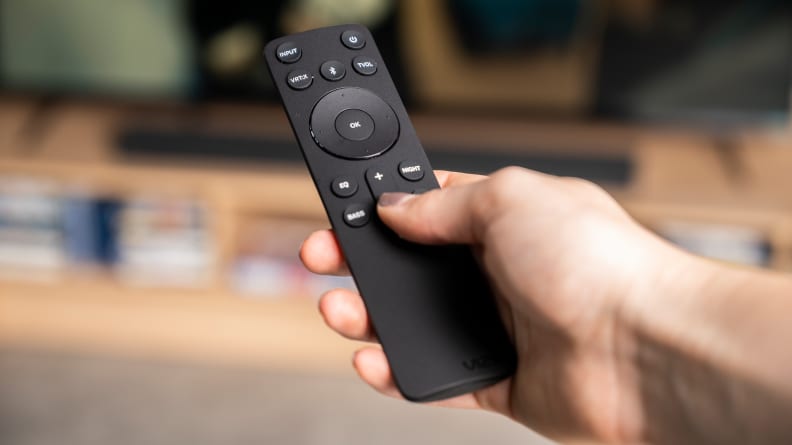
I had the opportunity to demo the AIO in front of a few (socially distanced) loved ones, who would be the first to admit that they don’t have an ear for audio. However, when conducting an informal blind A/B test thanks to the remote’s DTS Virtual:X button, each individual reported hearing a fuller sound that seemed to engulf the living room’s open floor plan more effectively when the feature was turned on.
That confirmed my own observations of the AIO's implementation of DTS Virtual:X. Turning that feature on had a generally positive effect on most content I watched, creating a soundstage that seemed wider and more impactful, even in terms of lower frequencies. It left something to be desired, of course, as virtual sound formats sometimes do. Real surround sound setups showcases an expansive sound that's hard to replicate virtually, regardless of how well the technology tries. But with admittedly average ears as evidence, the use of DTS Virtual:X in the AIO is a noticeable, welcomed improvement for movies and TV.
What we don’t like
Low end has a low ceiling
With the obvious physical limitations of the AIO and its comparatively tiny subwoofers, bass was an anticipated issue. The woofers just don’t have the capacity to effectively reproduce the lowest frequencies, as evidenced by Vizio’s reported 50Hz-20kHz frequency range. Within those confines, the subwoofers suffice. But when content demands more of them, they suffer.
As previously noted, I recognized their limitations when playing songs with deeper bass notes. But it was more evident when watching movies or TV. I watched the season finale of The Mandalorian multiple times (because of course I did) with different audio equipment: first with the AIO, then with a budget home theater setup that included a dedicated subwoofer. It’s certainly not a perfect comparison, but it worked in the sense that it exposed the sheer difference in power and impact during important scenes. The theater setup had it, and it was painfully clear that the AIO didn’t.
This feels like a good time to point out that a $150 soundbar shouldn’t have the depth that a full home theater system possesses, and most don’t. Vizio’s AIO isn’t in the minority here. That being said, the Klipsch Cinema 400 can be had for just $30 on sale, and it delivers far more resonating low end thanks to its hefty subwoofer.
Dialogue gets lost in the action
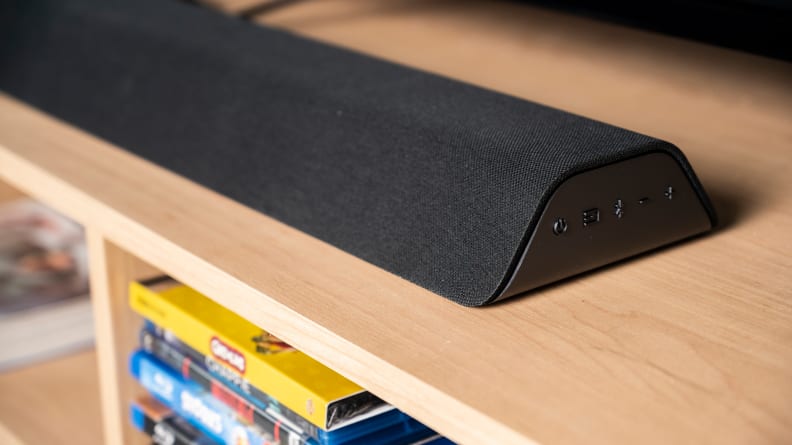
For standard viewing where the bar doesn’t need to be incredibly dynamic or detailed, the AIO doesn’t present any real deficiencies. It's a night-and-day improvement over the speakers in most modern TVs, and it provides audio clarity that wouldn't otherwise be a part of the experience. When watching more involved content where the AIO's 2.1-channel array becomes responsible for more frequencies and sounds, though, the absence of a dedicated center channel really starts to show.
Action flicks, for instance, can put considerable strain on the AIO. The six drivers are pushed tirelessly to deliver that bigger sound, and the result can force dialogue to take a back seat in some cases. Referencing The Mandalorian finale once more, as well as the recently released Wonder Woman 1984, I found myself riding the volume to try and find a happy medium where the dialogue was clear and the rest of the sound wasn’t overbearing.
Dialogue mode helps, but an EQ option to specifically adjust dialogue in the same way that the AIO allows you to play with the bass or treble would help even more. It is a 2.1-channel soundbar, to be fair, without a driver dedicated to dialogue like 3.1-channel bars have. But I would have appreciated the ability to try and remedy the bar’s dialogue shortcomings.
Give us WiFi, gosh darn it
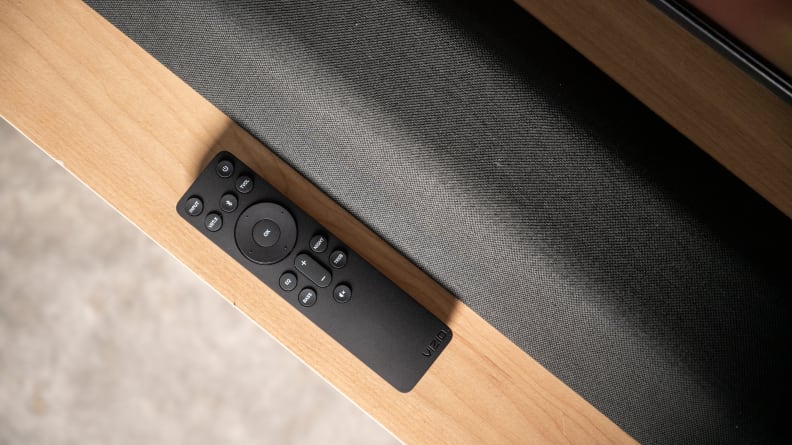
I get it. It’s a numbers game. For the cost of bringing an affordable soundbar to the market, Vizio couldn’t fit every feature under the shell of its AIO bar. There aren’t a ton of competitors with WiFi in this general price range, though there are some (see the Yamaha YAS-109). And Vizio does partially make up for it with a dedicated auxiliary input and Persistent Bluetooth feature that lets connected Alexa or Google Assistant devices respond even while enjoying other content.
Onboard WiFi, however, offers several benefits that have been exhaustively written about, from uninterrupted music streaming to over-the-air software upgrades and compatibility with applicable smart home devices. I’m not saying the Vizio AIO is a bad soundbar because it doesn’t have WiFi. I’m saying the Vizio AIO would be a better soundbar with WiFi introduced into the fray.
Should you buy it
Possibly, if you've got a tight space and an even tighter budget
Vizio's M-Series All-in-One is an affordable soundbar built to do certain things well. It’s meant to be ridiculously easy to unbox, set up and control, and it’s designed to instantly upgrade TV audio. Unequivocally, the AIO meets those demands and should be seen as a good value due to that alone.
If you can find some more room for the Klipsch Cinema 400, however, I’d recommend taking a hard look at spending the extra cash for significantly improved audio quality—especially if you can get it on sale. Another great alternative is the similarly-sized Yamaha YAS-109, which brings more powerful features (including WiFi connection) for a few bucks more, and still allows for a compact, subwoofer-free setup. Neither of these bars are as affordable as the AIO to date, but for many, the extra cost may be worth the added benefits.
If you come to terms with the fact that the AIO is a cheaper, but less capable alternative to those bars, chances are you’ll be happy bringing it home. That's especially true if you can find it on sale for its occasionally discounted price of $99. It will undoubtedly net you a better sound experience than your TV's speakers for a reasonable price, and will fit nicely into nearly any setup. It will not, however, meet the needs of someone accustomed to a more powerful home theater environment. All that’s left to do is determine which camp you’re in, and choose accordingly.
Meet the tester
Nick Woodard is a tech journalist specializing in all things related to home theater and A/V. His background includes a solid foundation as a sports writer for multiple daily newspapers, and he enjoys hiking and mountain biking in his spare time.
Checking our work.
Our team is here to help you buy the best stuff and love what you own. Our writers, editors, and experts obsess over the products we cover to make sure you're confident and satisfied. Have a different opinion about something we recommend? Email us and we'll compare notes.
Shoot us an email